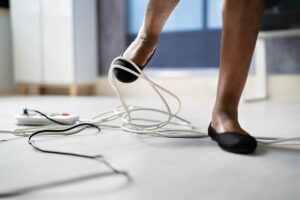Many big businesses rely on standby power when the power goes out for the safety of their employees and customers as well as to power essential items.
More and more home versions are being installed so families can have backup power when they need it to power appliances and essential medical equipment, or simply for convenience.
There is more than one type of permanent generator. One has a transfer switch that must be manually “thrown” before turning on the alternate source of power, which is wired into a house. This type of generator is permanent but not considered “standby” because of the manual switch, and it should not be located near a home. Consult a professional electrician when installing or maintaining a permanent generator.
Not throwing the switch can result in backfeeding, which sends electricity back into power lines, and can seriously injure or kill lineworkers or others.
Another type of fixed generator is permanently housed in a metal box usually located close to the house. It is the most expensive permanent generator—a standby version that is permanently and professionally installed to power most of the appliances in your home.
When needed, a standby generator automatically transfers the power source from the electric grid to the generator. The cost of this type of generator varies depending on how much backup power you want.
Besides the cost of the system, there are also installation costs to consider since it will need installed by licensed and bonded contractors. This is not a DIY project. Fixr.com estimates the national average install cost between $4,500 and $9,000 (not including the price of the unit).
When considering a standby generator, a representative from the supplier you select will assess your home’s energy needs and should ask you what you would like to power in the event of an outage. Other required steps include preparing a site near your current electrical meter and pouring a concrete pad.
The contractor(s) will install a new subpanel and automatic transfer switch. Your generator supplier should also create a detailed plan of which appliances and electronics should NOT be supplied with power during an outage, since the generator’s power supply can fluctuate and possibly damage sensitive items.
Cost considerations
According to Fixr.com, there are several cost considerations to having an all-house standby generator installed, which should be done by licensed and bonded mechanical and electrical contractors.
Installation should include:
- Assessing home energy needs to select suitable equipment. To project energy needs, total the kWs needed to power appliances and household systems you wish to run.
- Selecting equipment and getting installation requirements from contractor or supplier.
- Preparing the site nearest to current electrical meter and power panel.
- Getting an appropriately sized concrete pad poured.
- Having a propane or diesel fuel tank installed to feed generator during use. This must be done by a utility company. The tank can be buried or positioned next to equipment and professional connection by a licensed contractor is usually required. (Note, carbon monoxide detectors are required in homes with fossil fuel.)
- Having a new subpanel installed near the original electrical panel as well as an automatic transfer switch.
- A detailed plan of which appliances and electronic devices should be disconnected during use. Usually the installer configures which items will not be powered, such as televisions and computers, which could be damaged by the generator’s fluctuating energy supply.
- Bringing electrical wiring and lighting to code. This depends on the amount of work required, but electricians charge an average of $65 to $85 (or more) per hour. This project might be priced on a per item basis, or the electrician might simply base it on the square footage.
For more information about electrical safety, go to SafeElectricity.org.









